1942 SCHRADER
WW II U.S. NAVY MK V DIVE HELMET
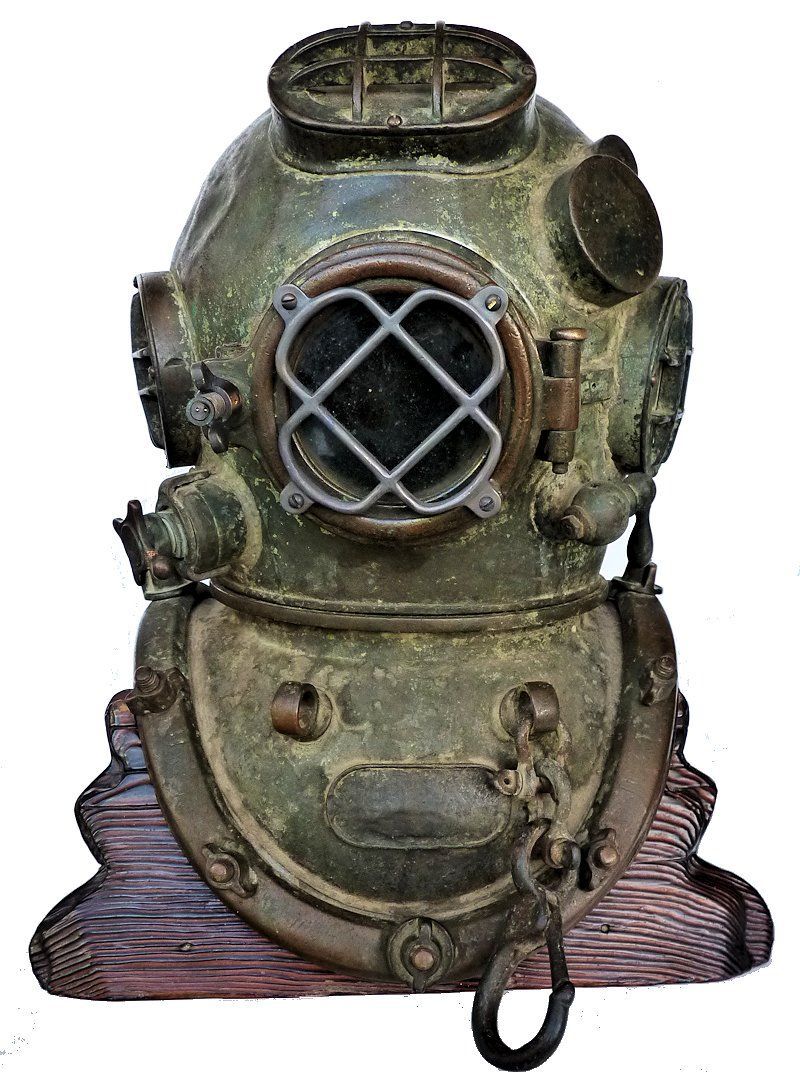
STAND NOT INCLUDED
Schrader was one of the original maker’s of Navy
MK V’s during WW II of which only 7200 MK V helmets were made.
TOTAL WEIGHT:
55 lbs BONNET: 33 lbs BREAST PLATE: 22 lbs
SERIAL NUMBER: 702
DATE: 1942
Presented is a U.S. Navy MK V helmet with an unusual dark green patina which was made by A. Schrader Diving Equipment Co.
in 1942. It was handed down in the family from the diver grandfather to his grandson and has just now come on the market.
HELMET MARKINGS: Authentic 12 bolt, 4 light Schrader Navy MK V from 1942 with serial number 702 on
the bonnet’s inside neck ring. The bonnet also is stamped 694 on the outside speaker cup. These numbers
appear no where else. Except for Front and Back, all the brails are unmarked. The Navy Inspector’s mark of a “U anchor
S” does not appear on this helmet. An unmarked check valve is fitted to the air supply elbow.
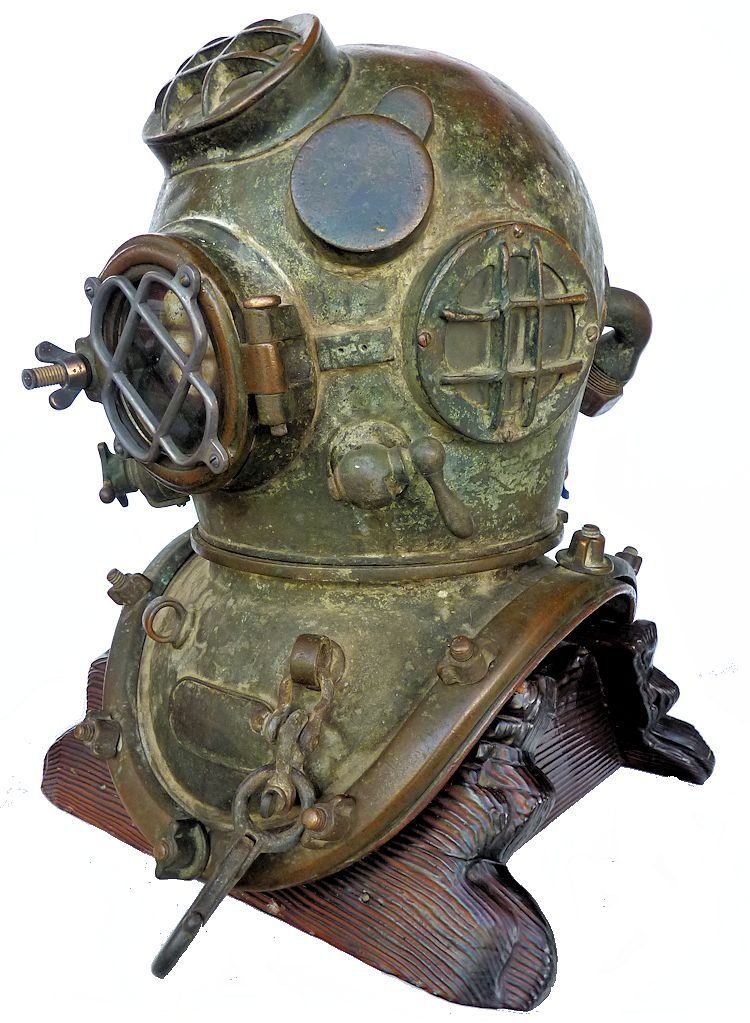 |
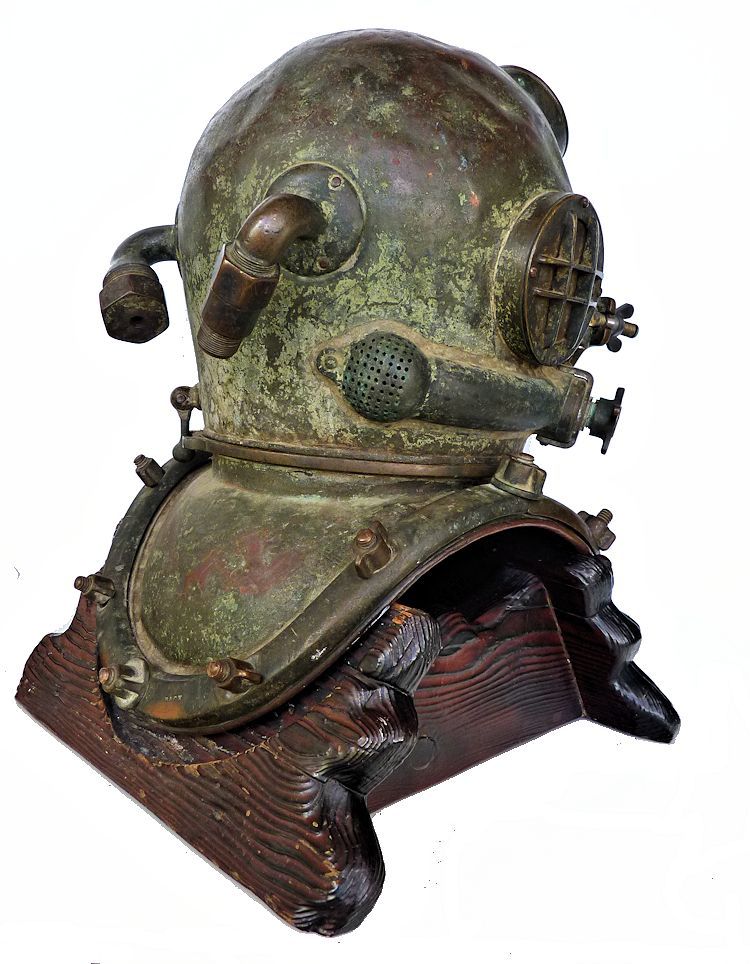 |
Partial front over back view of helmet
CONDITION:
Considering it’s 74 year age and marks of heavy use, it is in very good condition overall. A cap is fitted to
the air supply elbow. There are numerous small and larger dents and abrasions all over the bonnet showing its years of
considerable use. The air vents
are all intact. The front door guard, butterfly nut and shaft are recent replacements. The spit cock handle is bent
and is frozen. There is a speaker. A check valve is fitted as is a large nonregulation snap shackle
on the left suspension ring.
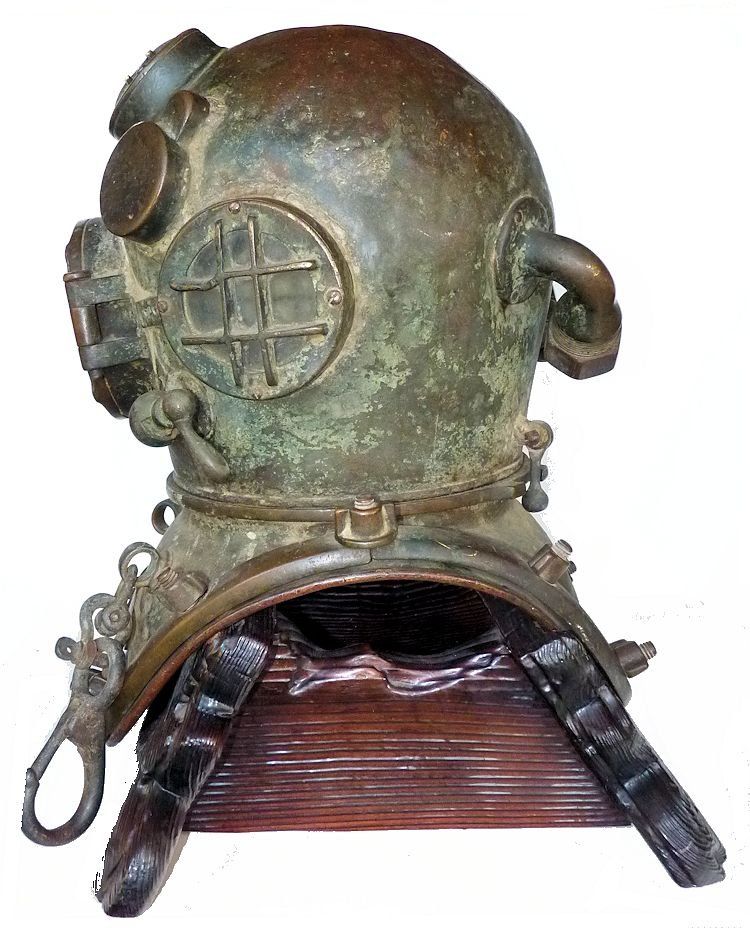 |
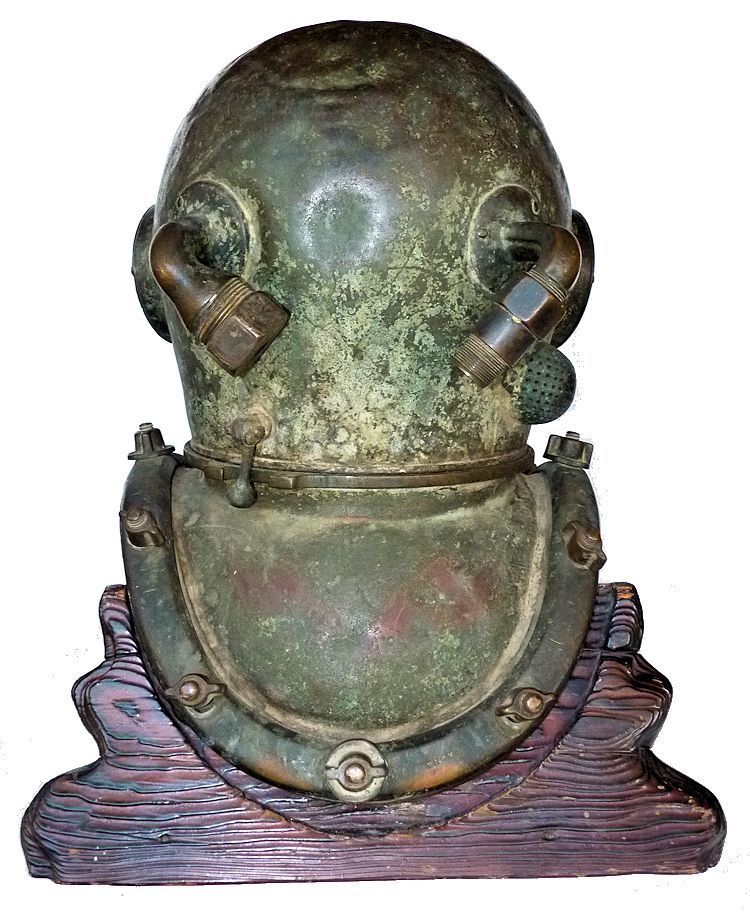 |
Left and Back side of the helmet.
The stand is NOT INCLUDED!
The back of the helmet shows the cap on the comm elbow
Like all
used diving gear, this is being sold for DISPLAY ONLY. It should not be dived without having passed inspection by a certified
dive shop.
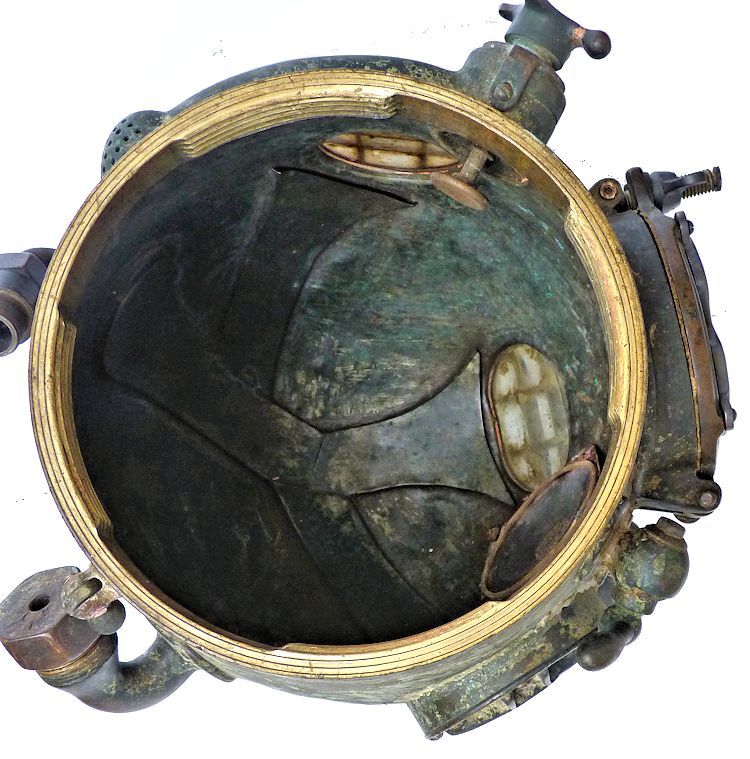 |
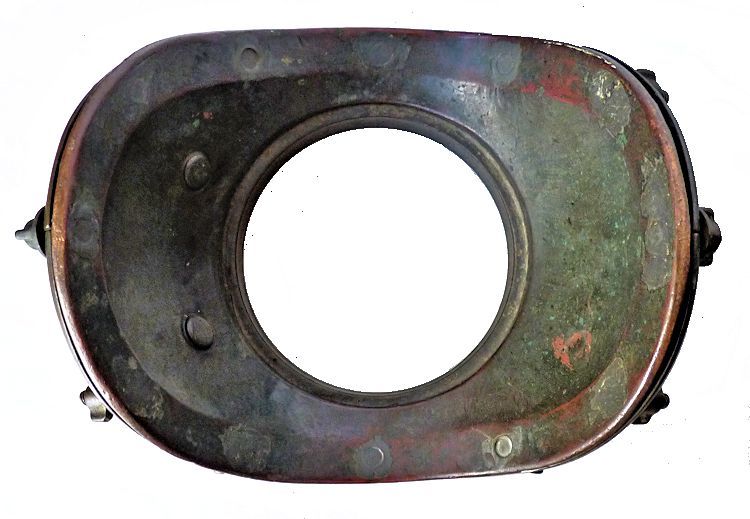 |
Top:
Perfect vents shown inside of bonnet. Bottom: Inside of the breast plate
HISTORY OF SCHRADER DIVING: Schrader is one of the oldest names in U.S. diving, second only to Morse. The founder, August
Schrader was a creative and inventive German immigrant who originally set up a shop dealing in rubber products in New
York City, NY in 1839, only a few years after A.J. Morse set up shop in
Boston.
In
1845 he began supplying fittings and valves for rubber products made by the Goodyear Brothers. Schrader was also a maker
of daguerreotype apparatus. His original shop was at 115 John Street Manhattan, NY. Shortly thereafter he went into partnership with Christian Baecher.
Christian was a brass turner and finisher which provided a foundation for what followed. The two partners, having watched divers at work at a nearby New
York Harbor jetty, decided to improve the diving helmets in use at the time. In 1849, with the help of Baecher,
he created a new copper helmet. Later his interest in diving led to him to design an air pump. Around
1890, August Schrader saw the need for a bicycle tire valve. By 1891, he produced the Schrader valve. The Schrader valve was
his most popular invention, and is still used today. In
1917, the United States Bureau of Construction & Repair introduced the MK V helmet and dress, which then became the standard
for US Navy diving until the introduction of the MK 12 in the late nineteen seventies. Schrader and Morse Diving were
the two original suppliers.During
the onslaught of World War Two only Morse and Schrader were making dive helmets for the navy. DESCO and Miller-Dunn went
into production around 1943. In total only about 7,000 MK V helmets were produced by all four companies during the war years
with DESCO producing the most, then Morse, Schrader and Miller-Dunn. The scarcity of the latter two are the reason they command
a higher price in the market.
BRIEF
HISTORY of NAVY MK V DEEP SEA DIVING DRESS:
By
1915, the Bureau of Construction and Repair had designed the MK V Diving Helmet which seemed to address many of the problems
encountered in diving. This deep-sea outfit was designed for extensive, rugged diving work and provided the diver maximum
physical protection and some maneuverability. The
1915 MK V Diving Helmet had an elbow inlet with a safety valve that allowed air to enter the helmet, but not to escape back
up the umbilical if the air supply were interrupted. Air was expelled from the helmet through an exhaust valve on the right
side, below the port. The exhaust valve was vented toward the rear of the helmet to prevent escaping bubbles from interfering
with the diver’s field of vision.
By
1916, several improvements had been made to the helmet, including a rudimentary communications system via a telephone cable
and a regulating valve operated by an interior push button. The regulating valve allowed some control of the atmospheric pressure.
A supplementary relief valve, known as the spitcock, was added to the left side of the helmet. A safety catch was also incorporated
to keep the helmet attached to the breast plate. The exhaust valve and the communications system were improved by 1927, and
the weight of the helmet was decreased to be more comfortable for the diver. After
1927, the MK V changed very little. It remained basically the same helmet used in salvage operations of the USS S-51 and USS
S-4 in the mid-1920s. With its associated deep-sea dress and umbilical, the MK V was used for all submarine rescue and salvage
work undertaken in peacetime and practically all salvage work undertaken during World War II. The MK V Diving Helmet was the
standard U.S. Navy diving equipment until succeeded by the MK 12 Surface-Supplied Diving helmet in February 1980, which
in turn was replaced by the MK 21 in December 1993.
